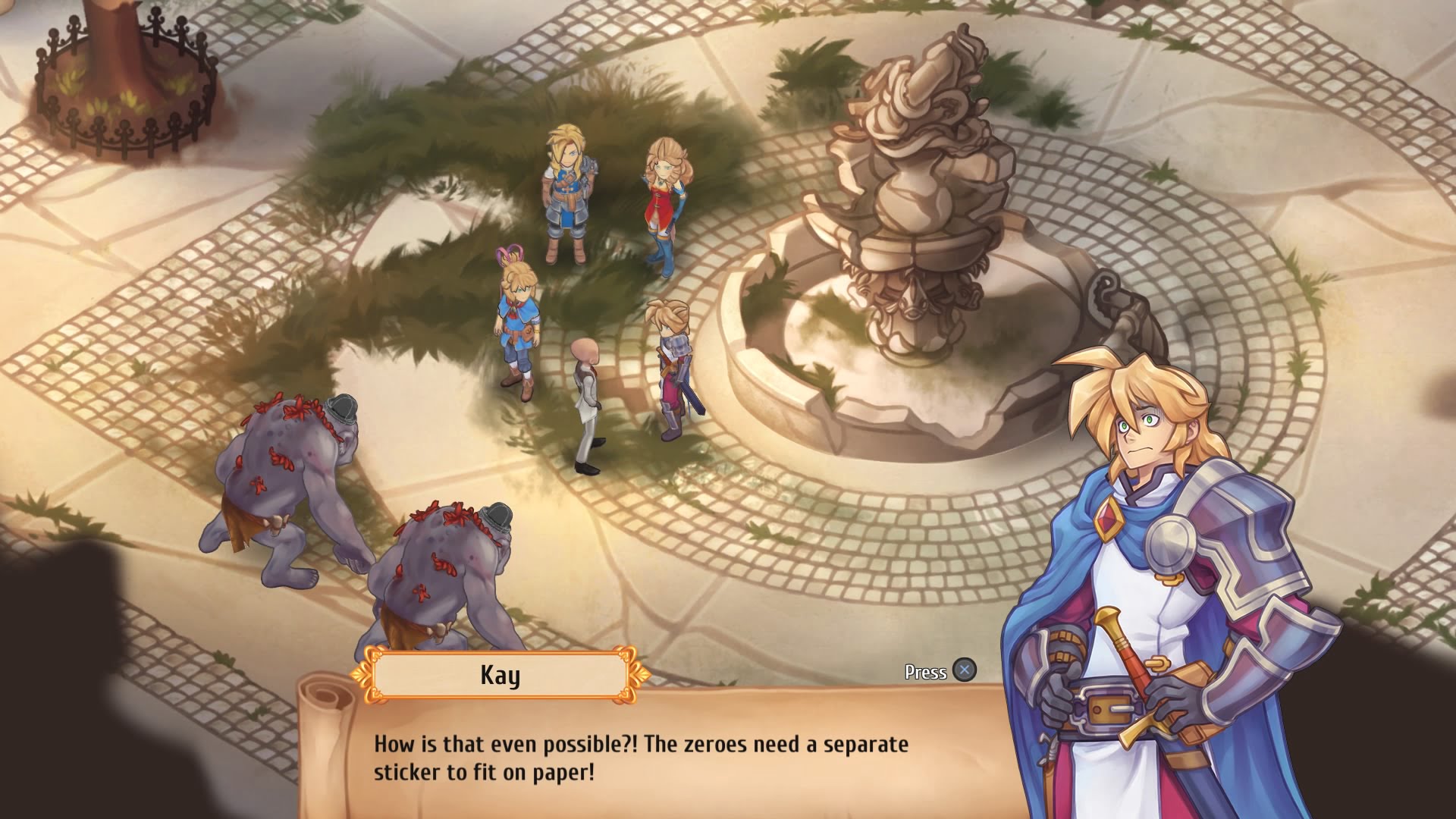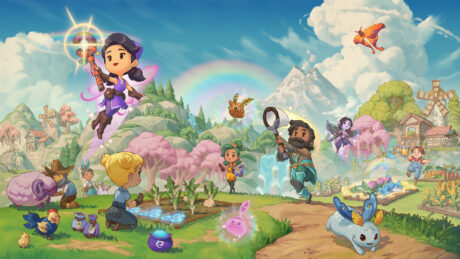Purrr....
- Humorous dialogue
- Storyline
- Characters
- Vibrant world
- Deep gameplay
- Difficulty options
- Replay value
Hisss!
- User interface
- Load times
- Drawn-out battles
Platform
Switch, PlayStation 4, Xbox One, PCPublisher
Klabater, Crunching KoalasDeveloper
Pixelated MilkGenre
RPG, Simulation, Strategy/TacticsPlayers
1File Size (Minimum)
4.27 GBRelease Date (NA)
May 18, 2017Filed Under
Regalia: Of Men and Monarchs is a turn-based, strategy role-playing game that is loaded with content, tricky tactics, and satisfying humor. After the project was successfully funded on Kickstarter in 2015, the game launched on Windows, Apple, and Linux in the second quarter of 2017 and jumped onto the PlayStation 4, Xbox One, and Nintendo Switch from there.
A Bad History to Take On
When it comes to role-playing games (RPGs), storylines play a key part, and Regalia doesn’t fail here. You play as Kay Loren, heir to the throne of House Loren. Your siblings and bodyguard travel with you to Ascalia to inherit your ancestors’ castle, but once you arrive, you find it’s a dump. And that’s not the only problem. Your ancestors have been piling up debt for generations, and now the debt collector, knowing who you are, is asking for their money. To pay it off, you’ll need to rebuild Ascalia, luring civilians back so they can open shops and refill the kingdom’s coffers.
From start to finish, the game’s dialogue is written remarkably well with interesting characters and humorous scripts for each individual you encounter. Kay himself feels like a person whose fitness to lead is questionable, but you will enjoy watching him grow and become a capable ruler.

Divide and Conquer
The game is divided into chapters, and in each one, Kay and his crew must accomplish goals in a certain amount of days in order to not only keep the debt collector happy but also get the kingdom back on its feet. This will require you to take on special quests such as exploring dungeons, erecting new buildings, and more, and the calendar is something you’ll need to pay close attention to if you want to succeed.
The game does not have a general world map where you manually move to your location. Instead, you choose a location on the map, and the game will automatically move you there. For every location you pass through, the game takes a day off your calendar, and exploring a dungeon takes additional time. As long as you keep track of your deadline for the chapter, you can venture far away from your kingdom, but when time is up, you’ll automatically be sent home to tally up what you have done. Just make sure you aren’t fishing for 45 days.
When going through dungeons, you aren’t roaming around on foot like in a traditional RPG. Instead, the setup is based on nodes, and there are three different types — combat, adventure, and camp — that you’ll need to explore to complete the dungeon.
In combat nodes, you fight enemies on a grid-style battlefield, and any party member that is defeated can no longer be used in a fight until you visit a camp node.
Adventure nodes are text-based quests. Similar to choose-your-own-adventures, you will select an answer from a set of questions, with some of them even returning you to the previous set, and depending on your answer, you’ll be granted money, building materials, weapons, potions, accessories, additional follow-up quests, or battles.
Camp nodes are essentially safe zones. This is where you can save your progress, heal your party before venturing further, and build bonds between characters. Most dungeons only have one camp node and it is highly recommend you take advantage of it.
As a side note, be aware that the game tends to have long load times between battles and events. In some cases, it’s so long that you can go to the kitchen for a snack before it’s finished.

Take Your Time to Draw Out Your Weapon
Being a tactical game, the battles take place on a Chess-like grid, and each battle has main goals to accomplish, with additional goals (and rewards) available for brownie points. When battling, you are given a specific amount of points to either commence an action for your party or against enemies.
You’ll have a set of skills to use, each one with an unique ability. However, you can only use those attacks once every few turns, similar to a cooldown. The game details the ability on the screen, which saves you from having to memorize it, but some descriptions can be confusing so you may find yourself gambling on an attack rather than decrypting what it actually does.
Battles can easily take over 15 minutes to complete, but the game gives you the option to speed up character movements and attacks to help relieve some of the time spent. After doing a few battles, though, you may begin to lose patience at the tempo of battle and, at times, the overall difficulty.
Unlike many RPGs, characters do not have his or her own level. Instead, the game is based on party levels, which can go as high as 20, so you can’t really grind your way to success like in other role-playing games. In order for characters to improve their individual skills and stats, he or she can equip a certain amount of “perks” such as weapons and accessories. Still, the toughness of the battles on the default mode can be overwhelming. Fortunately, the game offers various difficulty settings — one of them being the “Story Mode” where you have the option to skip battles and focus on everything else the game has to offer. Even there, you’ll spend over 20 hours on the other stuff, and that number increases to over 35 hours if you do take on each battle in the game’s storyline.

Deep Playthrough
Restoring the kingdom requires more than just battling. You will also need to help improve all the buildings in Ascalia. Fortunately, there aren’t too many in need of repair, and after fixing them up, you can increase each building’s level up to three, enhancing the quality of items or skills you can get, as well as improving your relationship with the townsfolk, with each level you add. You will need to improve the building at least once if you are to bring people into your kingdom, which you’ll want to do to complete each chapter. Just remember to watch the calendar since each time you interact with the townsfolk or even fish at the dock, a day will be taken away.
In addition to restoring buildings, Regalia gives you the option to build personal bonds with the characters around Kay Loren. Friendships have multiple stages, and after unlocking each one, new skills and shop improvements become available to Kay and his kingdom. For the final stage, you may have to finish a special quest or raise the character’s building to its maximum level. Don’t fret if you cannot complete everyone’s friendship before the story is over; you will have plenty of time to do so afterward.

Can You Repeat That?
Many RPGs have a formula of teaching players how to play, and Regalia certainly doesn’t hold back, unloading stack after stack of tutorial notes as soon as you start playing. There is a good amount of reading to do, and it is a lot to take in. Unfortunately, the user interface doesn’t display the information as well as it could, leading to confusion.
Instead of spacing out the content, everything feels jammed onto a screen. This may have worked well on a computer monitor since players are playing at a much closer distance, but it’s not as effective on a far-away television set or a smaller screen like the Nintendo Switch’s. For example, when viewing the game’s menu, you have a set of category tabs at the top you can view, but it can be hard to figure out that they’re actually there. The only indication you’re given on the tabs is a small, decorative icon at the end of each one. The icon doesn’t animate, and the tab itself isn’t highlighted either; it is just a graphic that easily blends into the design. Players will have to flip back and forth between tabs to see any indication that they’re active.
The game’s overall visual style is fine, but simplifying the way the menu and content is displayed would make it much easier for players to understand what they’re being shown.

Whimsical with Character
The world of Ascalia has uniquely drawn illustrations that are both colorful and intriguing. Each character is designed differently, matching the individual personalities, such as Kay looking more frail than his bodyguard and the fact that the alchemist wears a gas mask. That extends to the locations you visit in the kingdom, too. The area for the aforementioned alchemist rocks a steampunk-style interior, and the other places work equally well for the corresponding characters.
Summary
Regalia: Of Men and Monarchs is an interesting RPG that offers a tons of comedic dialogue and deep gameplay in the well-drawn world of Ascalia. While the game’s user interface and drawn-out battles can put a damper on players’ enjoyment, the various gameplay modes thankfully make the game accessible for everyone. With a little hard work, this kingdom may be one worth saving, after all.
Disclaimer: A digital review copy was provided by Crunching Koalas.









